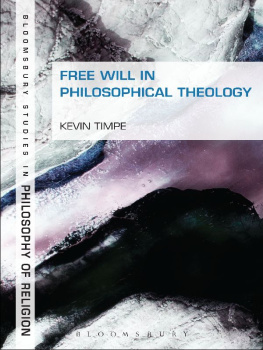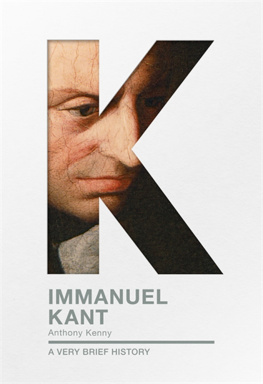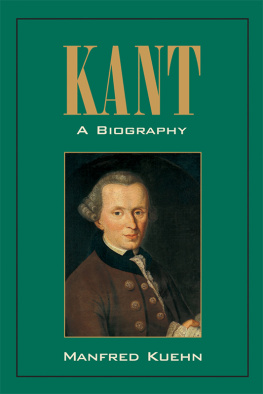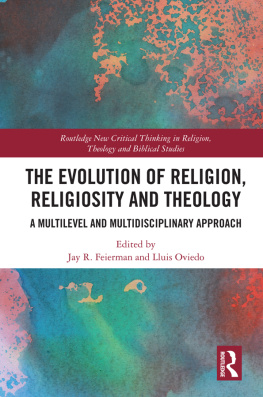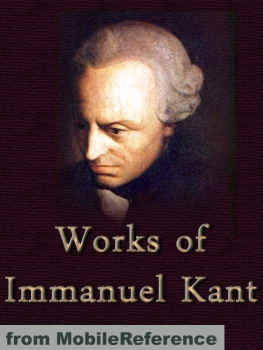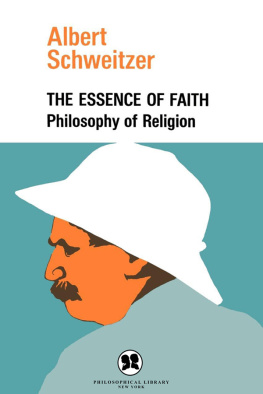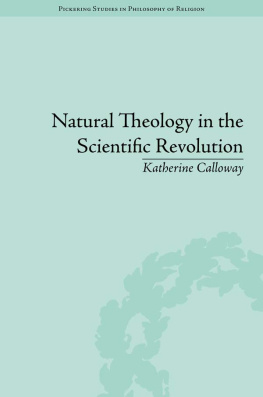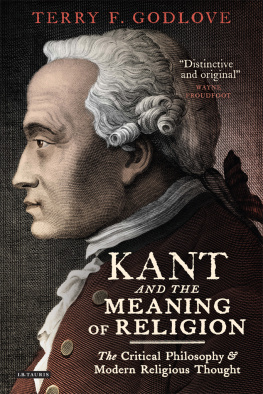Preparation for Natural Theology
Kants Sources in Translation
The texts that shaped Kants thought
Series Editors
Lawrence Pasternack, Professor of Philosophy, Oklahoma State University, USA
Pablo Muchnik, Associate Professor of Philosophy, Emerson College, USA
Editorial Board
Fred Beiser, Syracuse University, USA; Karin de Boer, KU Leuven, Belgium; Ubirajara Rancan de Azevedo Marques, So Paulo State University, Brazil; Corey Dyck, Western University, Canada; Paul Guyer, Brown University, USA; Heiner Klemme, Martin Luther University of Halle-Wittenberg, Germany; Ricardo Pozzo, Sapienza University of Rome, Italy; Eric Watkins, University of California, San Diego, USA; Guenter Zoeller, Ludwig Maximilian University of Munich, Germany.
The aim of this series is to retrieve the rich intellectual world that influenced Kants philosophical development. Many of these sources are in Latin or in German, and remain inaccessible to Anglophone readers.
Available titles
Excerpt from the Doctrine of Reason , Georg Friedrich Meier
Preparation for Natural Theology, Johann August Eberhard
Forthcoming titles
Ethica philosophica , Alexander Gottlieb Baumgarten
Initia philosophiae practicae primae acroamatice , Alexander Gottlieb Baumgarten
Jus naturae in usum auditorium , Gottfried Achenwall
To William
Courtney D. Fugate
To my parents, Lawrence and Anna-Marie
John Hymers
Preparation for Natural Theology
With Kants Notes and the Danzig
Rational Theology Transcript
Johann August Eberhard and Immanuel Kant
Translated and edited with an introduction and notes by
Courtney D. Fugate and John Hymers
Bloomsbury Academic
An imprint of Bloomsbury Publishing Plc

Contents
We would like to thank Lawrence Pasternack and Pablo Muchnik for asking us to contribute to this series, Hanno Birken-Bertsch for advice on issues of German translation, and Frederick van Fleteren and Robert Dobie on issues of translation. We would also like to thank Andrew Wardell at Bloomsbury for his patience and help on this present work, and his colleagues Rachel Eisenhauer and Colleen Coalter belatedly for their excellent editorial work on our previous book. Courtney D. Fugate would like to thank the American University of Beirut as well as the Fox Center for Humanistic Inquiry at Emory University for support during the early stages of this project. John Hymers would like to thank Bob Zunjik for providing him with fascinating background material that hopefully someday will also become its own project, the students of his Metaphysics and Approaches to God classes for letting him try out this material on them, and the continued support and encouragement of La Salle University and the philosophy department in particular.
I
Before becoming a famous philosopher, Kant was a famous teacher. For over forty years, he lectured on a wide array of topics, ranging from metaphysics to mineralogy, physics to pedagogy, anthropology to logic. Before officially entering the ranks at the University of Knigsberg with the Inaugural Dissertation (1771), Kants living depended on the popularity of his lectures. He took them very seriously, and used, for each of them, one or another of the textbooks recognized by the Prussian authorities. In many cases, he used even the same copy for decades. These copies, as a result, accumulated scores of marginal notes (often referred to as Reflexionen ), which acted sometimes as reminders, sometimes as objections, and sometimes as springboards for Kants own thoughts.
This wealth of material has been transcribed and printed in the Akademieausgabe von Immanuel Kants Gesammelten Werken . Likewise, most of the extant notes composed by students who attended Kants lectures have also been incorporated into the Akademieausgabe . Over the years, these resources have received modest attention, but, with Cambridge University Presss translation of selected lectures and Reflexionen , interest in them, especially among Anglophone Kant scholars, has burgeoned.
Unfortunately, however, it is common for interpreters to overlook the fact that Kants lecture notes are not his own writings, but transcriptions from his students. Similarly, his Reflexionen , though of his own hand, are often just glosses on some point made in the textbook from which he was teaching. These materials, therefore, should not be considered in isolationthey are an outgrowth of the manuals Kant was using, part of an implicit dialogue with these authors, and, as any teacher would attest, often open to students misrepresentation. As stand-alone pieces severed from this context, it is impossible to know whether a particular Reflexion or lecture passage conveys Kants restatement of the textbook content, or is instead a qualification, extrapolation, criticism, or merely a digression on Kants part.
The goal of this series is to offer the tools necessary to reconstruct the context of Kants thought. Many of these sources are in Latin and in German, and have heretofore remained in the hands of specialists. Their reliable English translations will make them accessible to a much broader audience and help contemporary readers put Kants lectures, notes, and Reflexionen in perspective.
The first phase of this project will focus on the most important philosophical textbooks Kant used throughout his teaching career. In addition to newly translated material, each volume will be accompanied by a system of concordances that will allow readers to correlate Kants Reflexionen and lectures to their corresponding textbook passages. In a second phase, the series will cast a broader net and offer translations of influential German and Latin texts of the eighteenth century that are not currently available in English, or need updating. Combined, these efforts promise to give Anglophone scholars a more comprehensive picture of the intellectual world that made possible the German Enlightenment.
II
In the first volume of our series, the translation of Georg Friedrich Meiers Auszug aus der Vernunftlehre (Halle 1752), we presented one of the most enduring influences on Kants theoretical philosophy: the textbook he used throughout his logic courses during a period of forty years (175696). Our second volume, the translation of Johann August Eberhards Vorbereitung zur natrlichen Theologie zum Gebrauch akademischer Vorlesungen (Halle: 1781), does a comparable job, this time making explicit the background against which Kant developed his mature philosophy of religion.
Kant lectured on rational theology over fifty times as part of his regular commitment to teaching metaphysics. He devoted, however, only four coursesin the spring semester of 1774, in the winter semesters of 1783/4 and 1785/6, and again in the spring of 1787exclusively to this topic. One set of lecture notes ended up in the hands of Friedrich Theodor Rink, Kants famous editor, and were later anonymously edited and published by Karl Heinrich Ludwig Plitz as Lectures on the Philosophical Doctrine of Religion.other notes to have survived, the Danzig is arguably the closest record we have to what actually transpired in the classroom, and appears for the first time in English in this volume.
Like all Prussian professors at the time, Kant was required to adopt in his courses one of the manuals approved by the authorities. He naturally gravitated toward Alexander Gottlieb Baumgartens Metaphysica , one of the most influential examples of Wolffian rationalism. Part IV, Theologia Naturalis ( 8001000), served Kant to organize the bulk of his course. The introductory section, however, drew primarily from Eberhards Vorbereitung .


